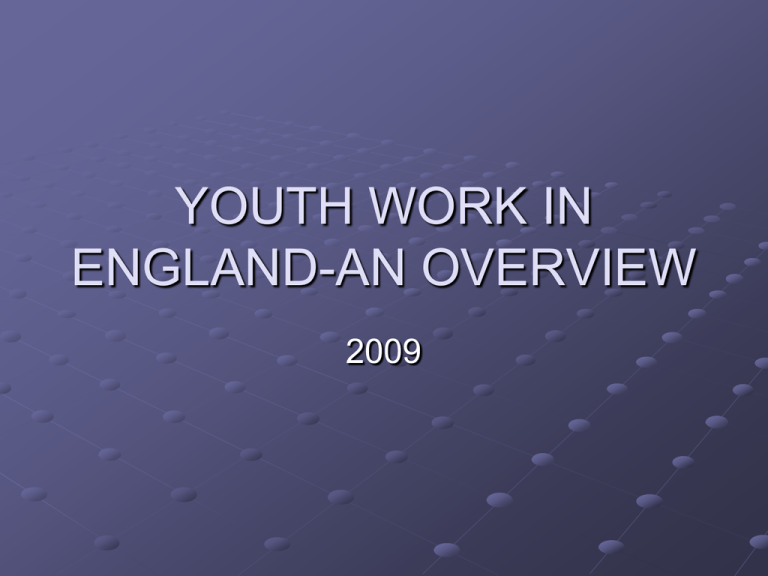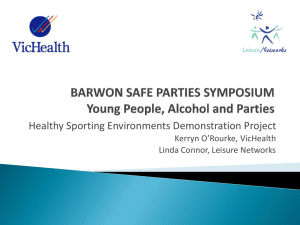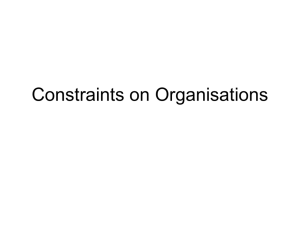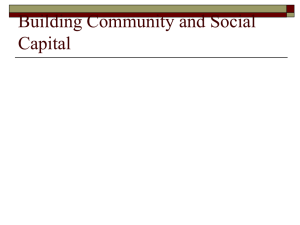YOUTH WORK IN ENGLAND
advertisement

YOUTH WORK IN ENGLAND-AN OVERVIEW 2009 History of youth work Origins in the Victorian era, starting with church movements such as the Methodists Youth clubs established in poor areas, uniformed groups start including scouts, etc Major change at the end of the second world war. Education Act of 1944 establishes requirement for local governments to provide youth provision History of youth work (cont.) 1960s, greater provision of youth projects and youth clubs 1980s, youth work moves into new areas of work, including detached youth work, youth information, etc 1990s, youth work becomes more involved with youth crime initiatives, drugs work and working more closely with social services, youth justice and the health Youth Work Today Youth work is located in: -General youth clubs -Local youth projects -specialist projects delivering: detached youth work, drugs education, citizenship in schools, alternative educational provision, sexual health, crime diversion, teenage pregnancy, participation and inclusion, health,etc. Youth Work Today Estimated 6,000 full-time youth workers nationally. Many thousands of part-time youth workers. Youth work is delivered by both the statutory (Local Government) sector and the voluntary (independent) sector. Youth work intervention now seen as an effective means of developing work with the ‘hard to reach’ What is youth work? Youth work is a process of informal personal, social and political education, founded on a voluntary relationship with young people, that strives to challenge discrimination, develop understanding and empower individuals and groups. What does the government mean by youth work? Youth service activities (by that they mean youth work) are primarily for personal and social development. They can be formal or informal. They must be linked to raising achievement and standards in education, training and employment or initiatives aimed at promoting inclusion and participation All the types of youth service provision must be focussed on youth work that is supporting formal and informal education, training or employment. Current changes in youth work – What are the contributing factors? Society - changing expectations and make-up Government - overarching priorities impacting upon youth provision Communities - safety and cohesion Young people - changing issues in the 21st Century A profession coming to terms with being professional Society An aging population Greater ethnic diversity Expectation that the state will provide Good citizenship versus the cult of the individual An unsure future for us all Government Restructuring the welfare state Enforcing social inclusion Immigration Europe Getting the unemployed back to work Redeveloping our inner cities Re-shaping education Dealing with crime Communities Breaking up of traditional communities Safety in our neighbourhoods Getting rid of the neighbours from hell Regenerating disadvantaged areas Greater community participation in decision-making Young People Education Health Physical Mental Sexual Employment- What job for life? Internet generation Drugs Crime Political disaffection Expectations versus reality Sense of identity The changing face of youth work “The new architecture” Professionalising the service Accountability Target driven service delivery Young people’s participation in structural development Training of full- and part-time youth workers Restructuring of local authority youth services Shortfall of qualified youth workers The fall, rise and fall of the voluntary sector What is bringing about these changes? Government Driven Agenda -Every Child Matters -Aiming high – 10 year youth strategy -Integrated services -Commissioning of public services - Involvement of young people in policy development - development of new partnerships - greater role for the voluntary sector - emphasis on training and qualifications for youth work staff to work in multi-agency environments Government Policy on Youth 1999-Present Nov 2006 Mar 2006 July 2005 Education Act July 2007 July 2004 5 Year Strategy for Children and Lerners Charities Act Oct 2006 Laming Report Nov 2004 Sept 2003 Children ECM Next Act Steps Youth Matters Next Steps Feb 2006 Transforming Youth Work Jan 2003 Spring 2001 Feb 2000 July 1999 Bridging the Gap Every Child Matters Dec 2002 Connexions Strategy Youth Matters Green Paper April 2005 Resourcing Excellent Youth Services Education and Inspections Act Local Government White Paper "Strong and Prosprous Communities" Aiming High 10 Year Strategy Where are we now? Every Child Matters and Youth Matters Integrated services/Children’s Trusts Extended Schools Positive activities Wholesale restructuring of public services Significant changes in the way that youth work is delivered Time of great uncertainty, challenge and opportunity











